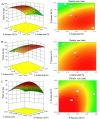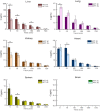Preparation and in vivo evaluation of an intravenous emulsion loaded with an aprepitant-phospholipid complex
- PMID: 36843571
- PMCID: PMC9979997
- DOI: 10.1080/10717544.2023.2183834
Preparation and in vivo evaluation of an intravenous emulsion loaded with an aprepitant-phospholipid complex
Abstract
In present, there was no detailed report on the formulation optimization and quality evaluation of aprepitant (APT) injectable lipid emulsion (APT-IE). The aim of the present investigation was to prepare and evaluate its properties of APT-IE loaded with an APT phospholipid complex (APT-PC) in vitro and in vivo. APT-PC was obtained by solvent evaporation with APT and phospholipids, then analyzed by X-ray diffraction, Fourier transform infrared spectroscopy and differential scanning calorimetry. Lipid emulsions are a new formulation that can reduce side effects and improve drug loading.APT-IE prepared by High-pressure homogenization and optimized by response surface methodology (RSM). The proportion of sodium oleate, poloxamer 188 and soybean oil were selected as variables for the optimization. The optimal formulation of ATP-IE had the following characteristics: particle size, 82.83 ± 1.89 nm; polydispersity index, 0.243 ± 0.008; zeta potential, -59.0 ± 2.54 mV; encapsulation efficiency, 98.84%±1.43%; drug loading, 7.08 ± 0.16 mg/mL; and osmotic pressure, 301 ± 2.15 mOsmol/kg. Transmission electron microscopy images indicated that the particle diameter of APT-IE was approximately 100 nm, with a morphology of spheroidal or spherical. APT-IE exhibited sufficient stability after storage at 4 ± 2 °C for more than 6 months. The results of the pharmacokinetic study demonstrated that APT-IE had the advantages of better safety, higher bioavailability, and obvious liver targeting than APT solution (APT-SL). The area under the curve (AUC) of APT-IE was 3-fold enhanced compared with APT-SL. The targeted enhancement multiple of APT-IE to liver tissue was greater than that of APT-SL. These results suggested that APT-IE has broad clinical application and industrial production potential.
Keywords: Aprepitant; lipid injectable emulsion; pharmacokinetics; response surface methodology; tissue distribution.
Conflict of interest statement
No potential conflict of interest was reported by the authors.
Figures












Similar articles
-
Aprepitant Intravenous Emulsion Based on Ion Pairing/Phospholipid Complex for Improving Physical and Chemical Stability During Thermal Sterilization.AAPS PharmSciTech. 2020 Jan 21;21(3):75. doi: 10.1208/s12249-019-1605-7. AAPS PharmSciTech. 2020. PMID: 31965388
-
Optimization, and in vitro and in vivo evaluation of etomidate intravenous lipid emulsion.Drug Deliv. 2021 Dec;28(1):873-883. doi: 10.1080/10717544.2021.1917729. Drug Deliv. 2021. PMID: 33960250 Free PMC article.
-
Aprepitant-loaded solid lipid nanoparticles: a novel approach to enhance oral bioavailability.Beilstein J Nanotechnol. 2025 May 15;16:652-663. doi: 10.3762/bjnano.16.50. eCollection 2025. Beilstein J Nanotechnol. 2025. PMID: 40438268 Free PMC article.
-
Aprepitant loaded solid preconcentrated microemulsion for enhanced bioavailability: A comparison with micronized Aprepitant.Eur J Pharm Sci. 2015 Oct 12;78:90-102. doi: 10.1016/j.ejps.2015.07.008. Epub 2015 Jul 9. Eur J Pharm Sci. 2015. PMID: 26165621
-
Formulation optimization of etoposide loaded PLGA nanoparticles by double factorial design and their evaluation.Curr Drug Deliv. 2010 Jan;7(1):51-64. doi: 10.2174/156720110790396517. Curr Drug Deliv. 2010. PMID: 20044908 Review.
Cited by
-
The Application of Metal-Organic Frameworks in Water Treatment and Their Large-Scale Preparation: A Review.Materials (Basel). 2024 Apr 24;17(9):1972. doi: 10.3390/ma17091972. Materials (Basel). 2024. PMID: 38730779 Free PMC article. Review.
-
Utilization of nanotechnology and experimental design in the development and optimization of a posaconazole‒calendula oil nanoemulgel for the treatment of mouth disorders.Front Pharmacol. 2024 Feb 15;15:1347551. doi: 10.3389/fphar.2024.1347551. eCollection 2024. Front Pharmacol. 2024. PMID: 38434704 Free PMC article.
-
Reversing the Natural Drug Resistance of Gram-Negative Bacteria to Fusidic Acid via Forming Drug-Phospholipid Complex.Bioengineering (Basel). 2024 Feb 11;11(2):177. doi: 10.3390/bioengineering11020177. Bioengineering (Basel). 2024. PMID: 38391663 Free PMC article.
-
Intravenous Nanoemulsions Loaded with Phospholipid Complex of a Novel Pyrazoloquinolinone Ligand for Enhanced Brain Delivery.Pharmaceutics. 2025 Feb 11;17(2):232. doi: 10.3390/pharmaceutics17020232. Pharmaceutics. 2025. PMID: 40006599 Free PMC article.
References
-
- Augustyn B, Stepien P, Poojari C, et al. (2019). Cholesteryl hemisuccinate is not a good replacement for cholesterol in lipid nanodiscs. J Phys Chem B 123:9839–45. - PubMed
-
- Carpentier YA, Dupont IE. (2000). Advances in intravenous lipid emulsions. World J Surg 24:1493–7. - PubMed
-
- Chu T, Zhang Q, Li H, et al. (2012). Development of intravenous lipid emulsion of tanshinone IIA and evaluation of its anti-hepatoma activity in vitro. Int J Pharm 42:76–88. - PubMed
MeSH terms
Substances
LinkOut - more resources
Full Text Sources
Other Literature Sources
